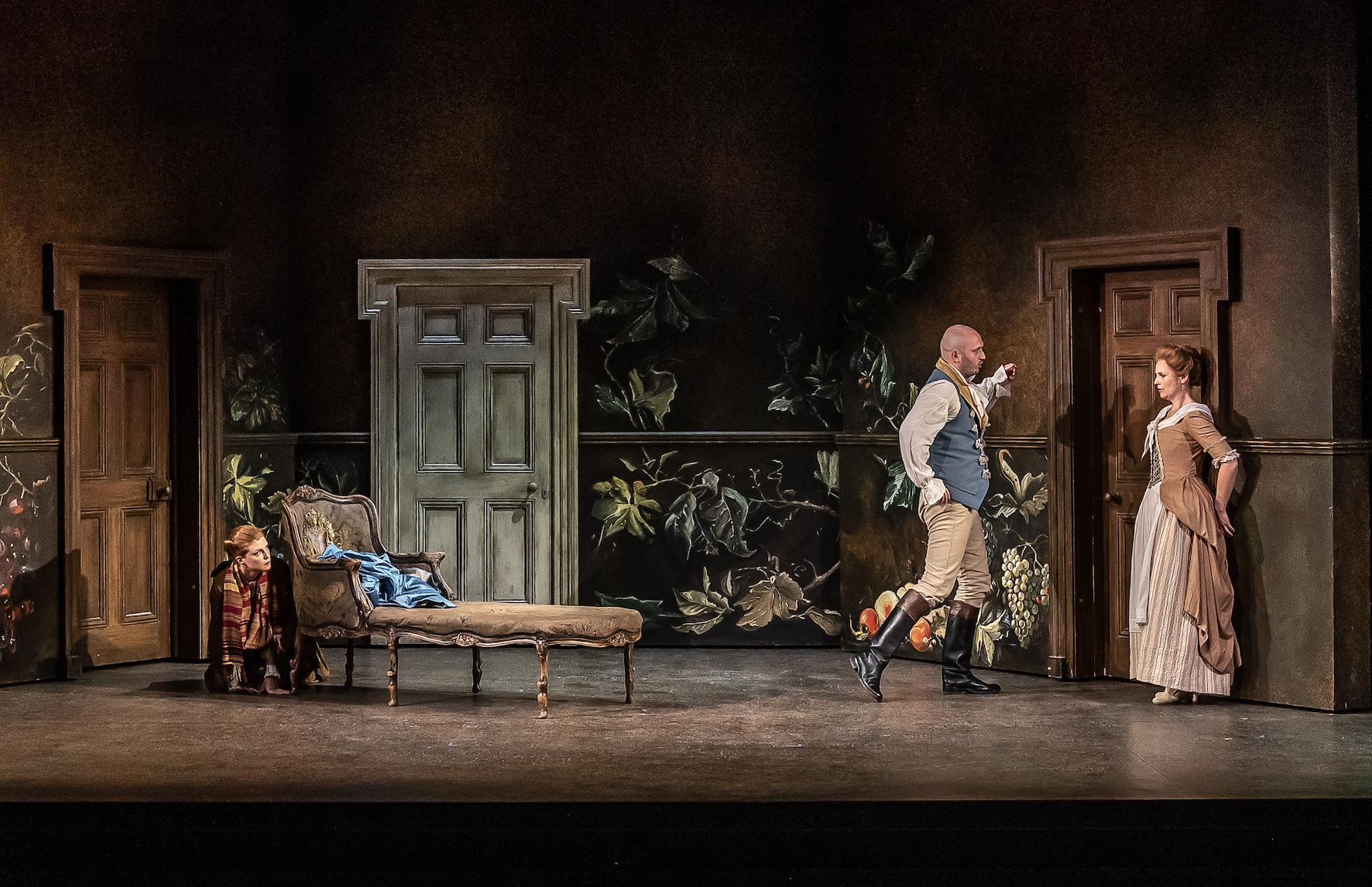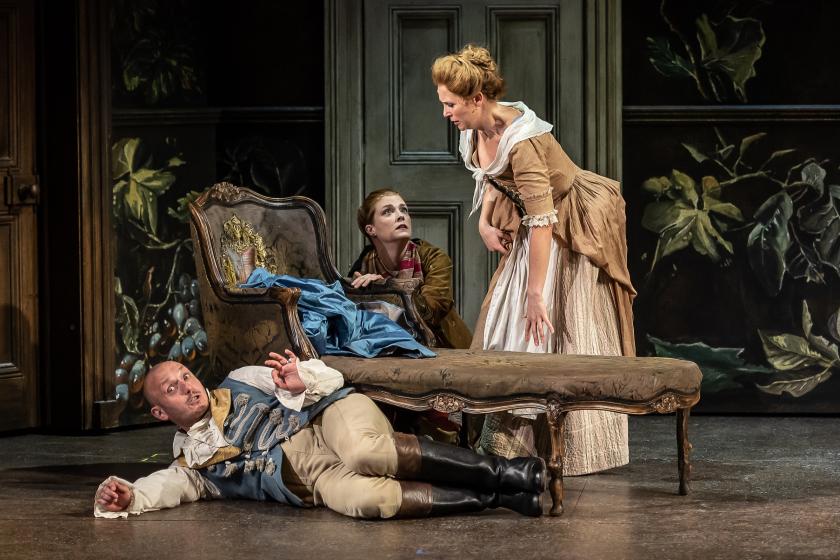Productions of The Marriage of Figaro tend to press their thumbs on the comic or tragic side of the scales that hover so evenly throughout Mozart’s inexhaustible work. Director Martin Lloyd-Evans mostly favoured a darker interpretation at The Grange Festival, despite long stretches of niftily managed funny business. In this perspective, we have to gaze hard at the abuse of power – by men over women, the rich over the poor, even the smart over the simple – as it shows its brutal as well as its seductive face.
Above all, Toby Girling’s strongly-sung Count Almaviva struts and roars not as some elegantly ageing seducer but a proper #MeToo-era villain: a bullet-headed baritone bruiser whose insistence on feudally entitled rape as “rights” truly chills the blood (Main picture). Yes, Girling’s vocal force and physical agility can wring some sympathy when his intellectual superiors, and social inferiors, thwart his overweening passions – as in the titanic hissy-fit of “Vedro mentr’io sospiro”. But you wouldn’t want to run foul of this utterly bitter Sevillian in either the chambers or the gardens of Tim Reed’s 18th-century sets. Gimmick-free, the design gives us a slightly scuffed and distressed aristocratic mansion, all faded duns and tans but decorated with poisonous-looking wreaths of foliiage and flowers. Even if the shadow of the guillotine doesn’t quite fall across the Count’s domains, as it can in more didactic productions, this ancien régime has apparently neared the end of its days. Which seems apt for a show mounted in the practical theatre built within this famously grand but shabby Baring-family property, hidden deep in the Hampshire countryside. You can imagine the action of Figaro unrolling through this very house and park.
Lloyd-Evans tangled up, and then unpicked, the plot’s complexities with a swift and sure directorial hand. No obtrusive big ideas interrupted the singing and acting, although the posies of flowers offered, spurned or finally accepted through the household’s twists and turns made an effective running metaphor. As for the principals, Simona Mihai’s long-suffering Countess achieved real pathos but without any false sense of serenity. Raw suffering drove her laments, and “Dove sono” became no wistful elegy but a frenzy of regret. I found her wide-spectrum vibrato disconcerting at times, if in keeping with the vulnerable edginess of this reading. Susanna began, to my ears, pleasantly if unremarkably, but Ellie Laugharne grew in authority and impact until a barnstormingly beautiful “Deh vieni” smashed the ball out of the park. As it happens, the tricksy business that accompanied this number – with the Countess, disguised as Susanna in her bridal veil, acting out the aria’s emotions – proved a rare case of directorial fussiness in this production. Wallis Giunta’s Cherubino (Pictured below left, with Toby Girling and Ellie Laugharne) rose to her/his big moments with winning assurance, although I found the coy vocal flourishes Giunta braided around “Voi che sapete” a little too charming for the lad’s/lass’s own good. And, as the once all-knowing but now thoroughly confused groom, Roberto Lorenzi as Figaro ladled on the old-school style with a robust attack that made his interludes of tenderness all the more telling.
 This, though, was a Figaro that spotlit the sheer danger and desperation of the solo passages, when baffled will and desire leads the schemers into rage or despair. Lorenzi could match Girling snarl-for-snarl for misogynistic fury in a soliloquy, as when he smouldered through “Aprite un po’ quegli’ occhi”. Some Figaro-lovers might have preferred a lighter touch for scenes such as this. But Lloyd-Evans created and sustained a piquant tension between the threadbare Rococo prettiness of his settings and the volcanic, often destructive, impulses they barely contain.
This, though, was a Figaro that spotlit the sheer danger and desperation of the solo passages, when baffled will and desire leads the schemers into rage or despair. Lorenzi could match Girling snarl-for-snarl for misogynistic fury in a soliloquy, as when he smouldered through “Aprite un po’ quegli’ occhi”. Some Figaro-lovers might have preferred a lighter touch for scenes such as this. But Lloyd-Evans created and sustained a piquant tension between the threadbare Rococo prettiness of his settings and the volcanic, often destructive, impulses they barely contain.
Smaller character parts seized their chances with relish and even distinction – notably, for me, Rowan Pierce’s witty and nimble Barbarina. The cast navigated through the majestic ensemble passages – always the ultimate test for both director and singers – with poise and precision. In Act Three, the glorious sextet (“Riconosci in questo amplesso") came off like a dream of heavenly, but essentially comic, harmony. Conductor Richard Egarr and the Academy of Ancient Music injected an enjoyable period pungency into the orchestral contributions, despite one or two uncertain moments. By the time of the third-act wedding festivities, they were playing with a cheeky swagger that reminded you of the sheer mischief that’s never far away in Figaro.
In this most Shakespearean of operas, we have to believe that comedy can outwit tragedy, and that redemption lies within the grasp of even a Count-grade exploiter. Lloyd-Evans and his team ensured that the closing miracle of forgiveness and reconciliation worked its magic without cynicism, with Mihai’s Countess no longer a scorned, frantic victim but a vision of healing grace. After all that resentment and narcissism cloaked in desire, at last we could hear that the “beautiful Venus” invoked by the Count might be more than a seducer’s figure of speech. This Figaro never flinched from the darkness at its heart, but rejoiced too in the return of light.















Add comment